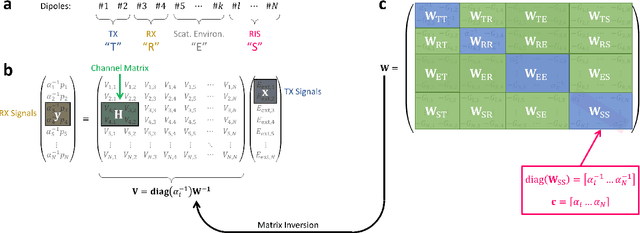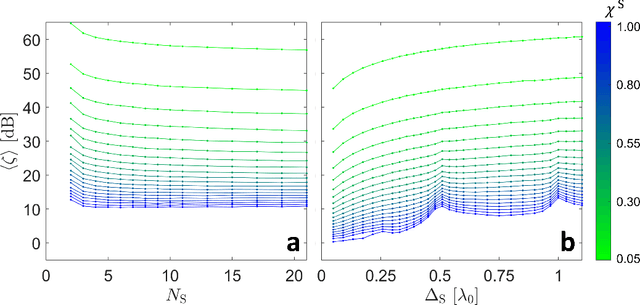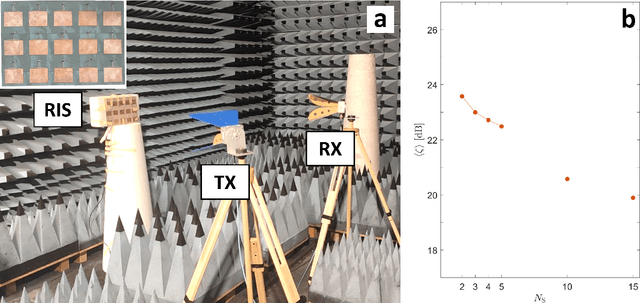Jérôme Sol
End-to-End Dynamic Metasurface Antenna Wireless System: Prototype, Opportunities, and Challenges
Jun 11, 2025Abstract:Dynamic metasurface antennas (DMAs) are a promising hybrid analog/digital beamforming technology to realize next-generation wireless systems with low cost, footprint, and power consumption. The research on DMA-empowered wireless systems is still at an early stage, mostly limited to theoretical studies under simplifying assumptions on the one hand and a few antenna-level experiments on the other hand. Substantial knowledge gaps arise from the lack of complete end-to-end DMA-empowered wireless system prototypes. In addition, recently unveiled benefits of strong inter-element mutual coupling (MC) in DMAs remain untapped. Here, we demonstrate a K-band prototype of an end-to-end wireless system based on a DMA with strong inter-element MC. To showcase the flexible control over the DMA's radiation pattern, we present an experimental case study of simultaneously steering a beam to a desired transmitter and a null to an undesired jammer, achieving up to 43~dB discrimination. Using software-defined radios, we transmit and receive QPSK OFDM waveforms to evaluate the bit error rate. We also discuss algorithmic and technological challenges associated with envisioned future evolutions of our end-to-end testbed and real-life DMA-based wireless systems.
Optimal blind focusing on perturbation-inducing targets in sub-unitary complex media
Jan 27, 2024Abstract:The scattering of waves in a complex medium is perturbed by polarizability changes or motion of embedded targets. These perturbations could serve as perfectly non-invasive guidestars for focusing on the targets. In this Letter, we theoretically derive a fundamental difference between these two perturbation types (the change of the scattering matrix is of rank one [two] for target polarizability changes [motion]) and identify accordingly optimal strategies to perfectly focus on the target in both cases. For target motion, at least two displacements are necessary. Furthermore, for the case of dynamic complex media additionally featuring parasitic perturbers, we establish a non-invasive scheme to achieve optimal time-averaged power delivery to a perturbation-inducing target. In all cases, no assumptions about the unitarity of the system's scattering matrix or the size of the perturbation are necessary. We experimentally demonstrate all results in the microwave regime using a strongly sub-unitary lossy chaotic cavity as complex medium. Our experiments highlight that the target's "structural scattering" is irrelevant [must be negligible] in the case of target polarizability changes [motion]. We expect our results to find applications in communications, cybersecurity, bioelectronics, flow-cytometry and self-propelled nano-swimmers.
Experimentally realized physical-model-based wave control in metasurface-programmable complex media
Jul 17, 2023Abstract:The reconfigurability of radio environments with programmable metasurfaces is considered a key feature of next-generation wireless networks. Identifying suitable metasurface configurations for desired wireless functionalities requires a precise setting-specific understanding of the intricate impact of the metasurface configuration on the wireless channels. Yet, to date, the relevant short and long-range correlations between the meta-atoms due to proximity and reverberation are largely ignored rather than precisely captured. Here, we experimentally demonstrate that a compact model derived from first physical principles can precisely predict how wireless channels in complex scattering environments depend on the programmable-metasurface configuration. The model is calibrated using a very small random subset of all possible metasurface configurations and without knowing the setup's geometry. Our approach achieves two orders of magnitude higher precision than a deep learning-based digital-twin benchmark while involving hundred times fewer parameters. Strikingly, when only phaseless calibration data is available, our model can nonetheless retrieve the precise phase relations of the scattering matrix as well as their dependencies on the metasurface configuration. Thereby, we achieve coherent wave control (focusing or enhancing absorption) and phase-shift-keying backscatter communications without ever having measured phase information. Finally, our model is also capable of retrieving the essential properties of scattering coefficients for which no calibration data was ever provided. These unique generalization capabilities of our pure-physics model significantly alleviate the measurement complexity. Our approach is also directly relevant to dynamic metasurface antennas, microwave-based signal processors as well as emerging in situ reconfigurable nanophotonic, optical and room-acoustical systems.
On the Tacit Linearity Assumption in Common Cascaded Models of RIS-Parametrized Wireless Channels
Feb 10, 2023



Abstract:We analytically derive from first physical principles the functional dependence of wireless channels on the RIS configuration for generic (i.e., potentially complex-scattering) RIS-parametrized radio environments. The wireless channel is a linear input-output relation that depends non-linearly on the RIS configuration because of two independent mechanisms: i) proximity-induced mutual coupling between close-by RIS elements; ii) reverberation-induced long-range coupling between all RIS elements. Mathematically, this "structural" non-linearity originates from the inversion of an "interaction" matrix that can be cast as the sum of an infinite Born series [for i)] or Born-like series [for ii)] whose $K$th term physically represents paths involving $K$ bounces between the RIS elements [for i)] or wireless entities [for ii)]. We identify the key physical parameters that determine whether these series can be truncated after the first and second term, respectively, as tacitly done in common cascaded models of RIS-parametrized wireless channels. Numerical results obtained with the physics-compliant PhysFad model and experimental results obtained with a RIS prototype in an anechoic (echo-free) chamber and rich-scattering reverberation chambers corroborate our analysis. Our findings raise doubts about the reliability of existing performance analysis and channel-estimation protocols for cases in which cascaded models poorly describe the physical reality.
 Add to Chrome
Add to Chrome Add to Firefox
Add to Firefox Add to Edge
Add to Edge